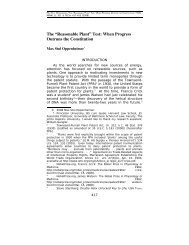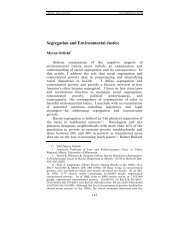An Organizational Approach to the Design of Patent Law
An Organizational Approach to the Design of Patent Law
An Organizational Approach to the Design of Patent Law
Create successful ePaper yourself
Turn your PDF publications into a flip-book with our unique Google optimized e-Paper software.
6 VERTINSKY FINAL_JAD (DO NOT DELETE) 2/27/2012 2:20 PM<br />
2012] AN ORGANIZATIONAL APPROACH 249<br />
problems, and at what cost. 172 More generally, governance<br />
structures can be compared in terms <strong>of</strong> multiple distinctive attributes—markets<br />
have very different attributes than direct<br />
regulation. 173 These attributes will impact <strong>the</strong> cost and feasibility<br />
<strong>of</strong> transactions. 174 Policy design includes examining <strong>the</strong><br />
alignment <strong>of</strong> governance structure with transactional structure<br />
<strong>to</strong> produce desirable outcomes. Examples <strong>of</strong> policy strategies<br />
include reallocating transactions across alternative governance<br />
structures <strong>to</strong> reduce transaction costs—perhaps by increasing<br />
or decreasing <strong>the</strong> level <strong>of</strong> integration within a firm versus use<br />
<strong>of</strong> <strong>the</strong> market. 175 The literature on vertical integration and <strong>the</strong>ories<br />
<strong>of</strong> <strong>the</strong> firm play an important role here. 176<br />
<strong>An</strong>alysis includes not only public governance structures<br />
such as governments, courts, and agencies such as <strong>the</strong> USPTO<br />
and <strong>the</strong> United States International Trade Commission (ITC),<br />
but also private systems <strong>of</strong> contracting and enforcement such<br />
as markets, firms, and o<strong>the</strong>r forms <strong>of</strong> collaboration such as patent<br />
pools. 177 North’s focus on <strong>the</strong> political economy <strong>of</strong> rulemaking<br />
reminds us that implementation <strong>of</strong> <strong>the</strong> rules will inevitably<br />
be imperfect and costly, that alternative governance structures<br />
will alter how <strong>the</strong> rules impact incentives and <strong>the</strong> structure <strong>of</strong><br />
transactions, and that many activities will occur through pri-<br />
172. See Williamson, supra note 75, at 603 (“We thus begin with au<strong>to</strong>nomous<br />
contracting, which is <strong>the</strong> ideal transaction in both law and economics:<br />
‘sharp in by clear agreement; sharp out by clear performance.’” (quoting Ian R.<br />
Macneil, The Many Futures <strong>of</strong> Contracts, 47 S. CAL. L. REV. 691, 738 (1974))).<br />
173. Id. at 599.<br />
174. Id.<br />
175. Id.<br />
176. E.g., Martin J. Adelman, The Supreme Court, Market Structure and<br />
Innovation: Chakrabarty, Rohm and Haas, 27 ANTITRUST BULL. 457, 459–60<br />
(1982); Dan. L. Burk & Brett H. McDonnell, The Goldilocks Hypo<strong>the</strong>sis: Balancing<br />
Intellectual Property Rights at <strong>the</strong> Boundary <strong>of</strong> <strong>the</strong> Firm, 2007 U. ILL.<br />
L. REV. 575; Merges, A Transactional View <strong>of</strong> Property Rights, supra note 15;<br />
Merges, Intellectual Property Rights, Input Markets, and <strong>the</strong> Value <strong>of</strong> Intangible<br />
Assets (1999) (unpublished working paper), available at<br />
http://www.law.berkeley.edu/files/iprights.pdf; David J. Teece, Firm Organization,<br />
Industrial Structure and Technological Innovation, 31 J. ECON. BEHAV. &<br />
ORG. 193 (1986).<br />
177. See, e.g., Robert P. Merges, Contracting in<strong>to</strong> Liability Rules: Intellectual<br />
Property Rights and Collective Rights Organizations, 84 CALIF. L. REV.<br />
1293 (1996) (surveying <strong>the</strong> diverse institutions various industries have cultivated<br />
<strong>to</strong> handle intellectual property transactions, and arguing that repeat<br />
players can and do come up with private solutions <strong>to</strong> overcome transactional<br />
bottlenecks).






